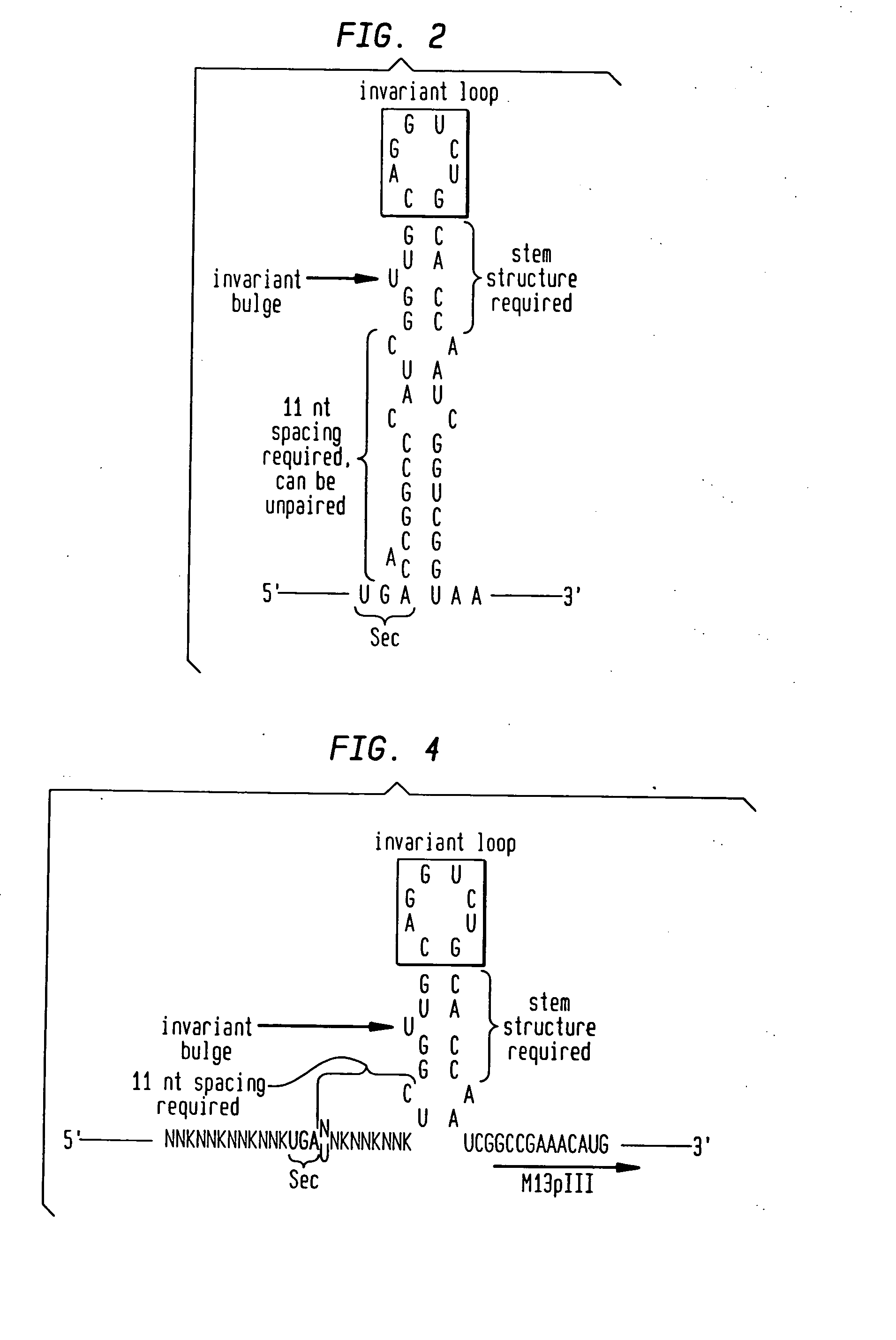Surface display of selenocysteine-containing peptides
a selenocysteine and surface display technology, applied in the field of selenocysteine-containing peptides, can solve the problems of inability to specifically modify displayed tyrosine with other chemical moieties, inability to identify which molecules bind to a given target from such a vast pool, and achieve the effect of improving the binding activity to the target protein
- Summary
- Abstract
- Description
- Claims
- Application Information
AI Technical Summary
Benefits of technology
Problems solved by technology
Method used
Image
Examples
example i
Expression of Native E. Coli fdh Sequences as M13 pIII Fusion
[0054] As a control, the native E. coli formate dehydrogenase (fdh) SECIS (FIG. 2, amino acid sequence Ser-Ala-Arg-Val-Sec-His-Gly-Pro (SEQ ID NO:28)) was cloned into M13KE, an M13mp19 derivative designed with Acc65I and EagI sites for pentavalent N-terminal pIII expression (Zwick, et al., Analytical Biochemistry, 264:87-97 (1998)). The following oligonucleotides were synthesized by the phosphoramidite method by the Organic Synthesis Division of New England Biolabs, Inc. (Beverly, Mass.). Acc65I and EagI restriction sites are indicated in bold.
[0055] fdh SECIS control oligonucleotide:
5′-CATGTTTCGGCCGTACCGACCGATTGGTGCAGACCTGCAACC(SEQ ID NO:29)GATGGGCCGTGTCAGACACGAGCGCTAGAGTGAGAATAGAAAGGTACCCGGGCATG-3′
[0056] Duplex extension primer (New England Biolabs, (Beverly, Mass.) product #8101):
5′-CATGCCCGGGTACCTTTCTATTCTC-3′(SEQ ID NO:30)
[0057] The fdh SECIS control oligonucleotide was synthesized, gel-purified, and annealed to...
example ii
Construction and Characterization of TGAN and TGAT Libraries
[0060] Based on the reported minimal SECIS requirements (FIG. 2) (Liu, et al., supra), a library consisting of the SECIS element with four upstream and three downstream randomized codons, and a minimal mRNA SECIS (TGAN library, FIG. 4), was prepared using the same cloning strategy described in Example I. The TGAN library oligo sequence was as follows, with Acc65I and EagI restriction sites in bold; M=A or C; N=A, C, T or G.
5′-CATGTTTCGGCCGATTGGTGCAGACCTGCAACCGAMNNMNNM(SEQ ID NO:33)NNTCAMNNMNNMNNMNNAGAGTGAGAATAGAAAGGTACCCGGG-3′
[0061] After duplex extension and restriction digestion, the resulting insert was ligated into M13KE, an M13mp19 derivative designed with Acc65I and EagI sites for pentavalent N-terminal pIII expression (Zwick, et al., supra). This vector also carries the lacZa fragment, resulting in characteristic blue plaques when plated with an α-complementing strain on X-gal medium. The sequences of selected clo...
example iii
Chemical Modification of Selenopeptide Libraries
[0068] To rule out the possibility of Cys incorporation at the TGA codon, and to demonstrate specific chemical modification of the Sec residue in a displayed peptide, the chemical reactivity of the fdh control phage clone Sec-1 (SARV-Sec-HGP) was compared to that of clone Cys-1 (SARVLCNH (SEQ ID NO:35)), which contains a single unpaired cysteine residue. Phage samples were treated with iodoacetyl-LC-biotin (I-Bt, Pierce), an electrophilic reagent which should specifically target thiol or selenol groups with the enzyme cofactor biotin. Phage (1010 pfu) in 150 mM sodium chloride, 50 mM glycine-HCl (pH 2.5) were combined with 50 μM iodoacetyl-LC-biotin in dimethylformamide (5% v / v) and incubated in the dark at room temperature for 10 min. The reactions were quenched by the addition of SDS gel loading buffer with 42 mM DTT, and samples were promptly denatured at 100° C. for 5 min and loaded on a 10-20% SDS-polyacrylamide gel. Immunoblotti...
PUM
| Property | Measurement | Unit |
|---|---|---|
| pH | aaaaa | aaaaa |
| pKa | aaaaa | aaaaa |
| pKa | aaaaa | aaaaa |
Abstract
Description
Claims
Application Information
 Login to View More
Login to View More - R&D
- Intellectual Property
- Life Sciences
- Materials
- Tech Scout
- Unparalleled Data Quality
- Higher Quality Content
- 60% Fewer Hallucinations
Browse by: Latest US Patents, China's latest patents, Technical Efficacy Thesaurus, Application Domain, Technology Topic, Popular Technical Reports.
© 2025 PatSnap. All rights reserved.Legal|Privacy policy|Modern Slavery Act Transparency Statement|Sitemap|About US| Contact US: help@patsnap.com



